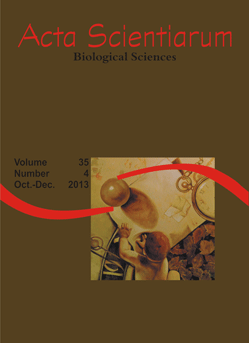<b>Structure of the periphytic algae associated with a floating macrophyte in an open lake on the upper Paraná river floodplain, Brazil</b> - doi: 10.4025/actascibiolsci.v35i4.18663
Resumo
We aimed to access the knowledge of the structure of the periphytic algae community on a floating substrate, the macrophyte Ricciocarpus natans (L.) Corda, during two hydrological periods in a connected environment at the Paraná river floodplain. Attached algal was removed from the substrate with the aid of a soft-bristled brush and distilled water jets and was fixed immediately for qualitative and quantitative analysis. The total richness of the periphytic algae was 188 taxa. February showed the highest species richness (154 taxa), while total species density exhibited an inverse pattern, with the highest values occurring in June (273.4 103ind. cm-2). Bacillariophyceae comprised the largest fraction of density, which was reflected by the abundance of Achnanthidium minutissimum (Kütz.) Czarn. Community structure of periphytic algae in R. natans followed the same pattern of other substrates, as previously determined. This suggests that main factor acting on the structure of periphyton at the Paraná river floodplain is primarily the floodpulses regime. The hydrochoric dispersion of R. natans across the various environments comprising the floodplain favors its communities associated, as the periphytic algae, subject to passive transport via water movement. Floating rhizoids of R. natans also may act as a mesh retainer, promoting the colonization of many metaphytic and planktonic species. However, in order to better understand and delineate patterns of ecosystem functioning, it is recommended that natural substrates be used which have greater stability in the environment, such as rooted or submerged macrophyte species.
Downloads
DECLARAÇÃO DE ORIGINALIDADE E DIREITOS AUTORAIS
Declaro que o presente artigo é original, não tendo sido submetido à publicação em qualquer outro periódico nacional ou internacional, quer seja em parte ou em sua totalidade.
Os direitos autorais pertencem exclusivamente aos autores. Os direitos de licenciamento utilizados pelo periódico é a licença Creative Commons Attribution 4.0 (CC BY 4.0): são permitidos o compartilhamento (cópia e distribuição do material em qualqer meio ou formato) e adaptação (remix, transformação e criação de material a partir do conteúdo assim licenciado para quaisquer fins, inclusive comerciais.
Recomenda-se a leitura desse link para maiores informações sobre o tema: fornecimento de créditos e referências de forma correta, entre outros detalhes cruciais para uso adequado do material licenciado.












1.png)




3.png)













